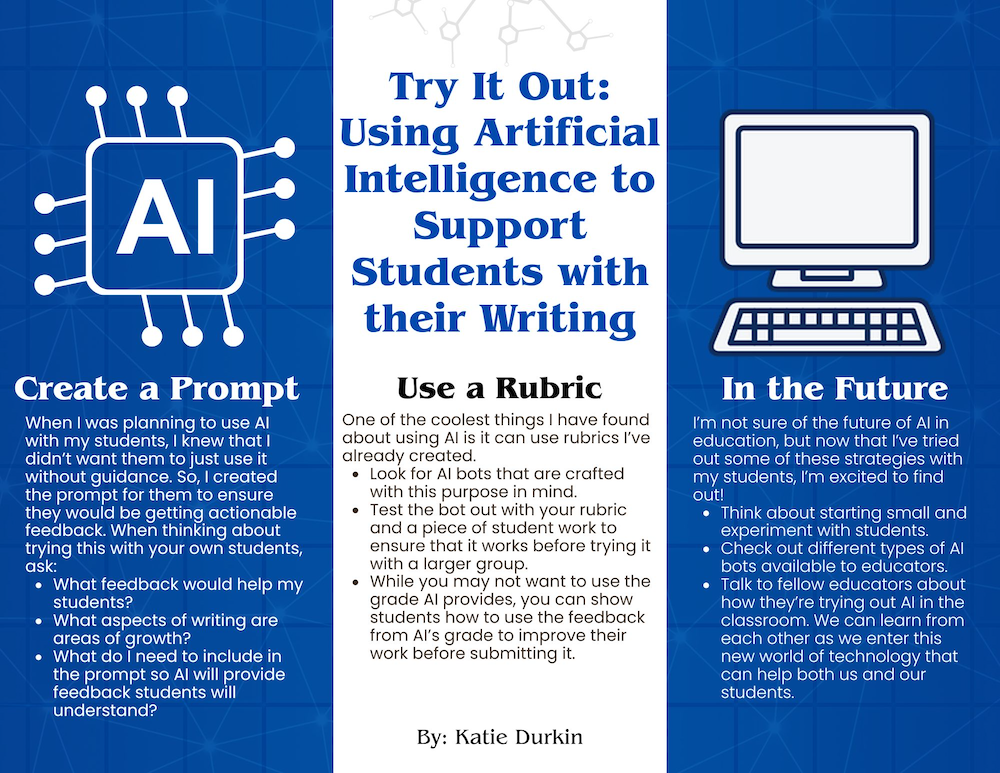By Katie Durkin

 I’m not sure if other writing teachers ever feel this way, but every time I give a writing assignment to my students, I am overwhelmed by what they create but also disappointed in myself that I can’t provide more support. I try my hardest to give feedback to all of them during the writing process, but I always feel like I’m falling short.
I’m not sure if other writing teachers ever feel this way, but every time I give a writing assignment to my students, I am overwhelmed by what they create but also disappointed in myself that I can’t provide more support. I try my hardest to give feedback to all of them during the writing process, but I always feel like I’m falling short.
This past fall I especially felt this way when my students were writing realistic fiction stories. They were asking me to provide more feedback and suggestions to push their stories, but there weren’t enough hours in the school day to give them all what they were craving.
Cue something I never thought I would ever use as a teacher: artificial intelligence. I’ve always been the teacher who has embraced new technologies, often volunteering to be the guinea pig. But when it came to AI, I was incredibly hesitant.
However, I’ve tried two strategies with my students this year that have totally shifted my thinking about using AI in the language arts classroom, and I think they’re worth sharing. I hope my experience will encourage other writing teachers to explore AI and see if they can increase the support their students want during the writing process.
Understandable Apprehension
Before I share the ways in which I tried out artificial intelligence with my students and their writing, I believe there are three important ideas to note.
First, I know many teachers are concerned that artificial intelligence will replace aspects of teaching. Based on my own experience, I don’t believe this is the case. While AI did provide my students with actionable feedback for their stories, I don’t think it proved to be a replacement for the integral writing conferences students participated in with both myself and their peers. There is something extremely important about feedback from a human being that changes the way a writer approaches their writing.
Second, I took the time to test out the two strategies I’m about to present with a small group of students before trying it with the larger group. I wanted to see if I agreed with the feedback AI was producing and to ensure it was grade-level appropriate. I also was hoping AI would provide suggestions to me that I could use personally to help them develop and improve their writing. In most cases, I found this to be true.
In my experimentation phase, I gathered feedback from students to ensure they felt comfortable using AI to help them with their writing and if they believed what AI provided them would assist them in pushing their writing. Students were actually surprised we would be using AI in this way and were excited to use the feedback provided.
Finally, I also think it’s important to note that I did not use ChatGPT. My district allowed us to pilot two AI programs this year: SchoolAI and Magic School. For the purposes of this project, I used SchoolAI with the students because it provided two AI bots specific to providing feedback with writing. One was the AI in Education Coach and the second was the Essay Grading Assistant.
For the purposes of my experimentation, both of these bots worked really well and provided students with myriad feedback they could use in their stories.
Trying It Out
The two strategies I tried with AI took place during two different revision cycles for my students’ realistic fiction short stories.
My first strategy was to have the AI in Education Coach bot give students feedback on their realistic fiction stories. However, I didn’t let students just go to AI without guidance. Rather, I drafted a prompt for students to use. This prompt stated:
I am writing a realistic fiction story that develops a main character who is dealing with a conflict. This conflict will unfold in multiple scenes in my story. I will need to develop a setting, an organized and logical plot, and a major theme for my realistic fiction story. I must include a flashback. This is in draft form. I would like for you to help give me feedback on my story, using multiple author’s techniques such as creating believable characters, grounding dialogue in scenes, SHOW, don’t TELL details, and proper grammar.
Once students provided AI with the prompt, I noticed that right away they received two possible options. One stated that students should share their story in order to receive feedback. The second AI response actually started giving actionable suggestions on parts of the prompt before the draft was included. For example, in some cases, students received suggestions about how to incorporate more Show, Don’t Tell into their stories. The students were then asked to copy and paste their stories into the AI bot.
What happened at that point (I thought!) was nothing short of magical.
AI provided them with a lot of feedback broken down into different bullet points depending on the parts of their story AI believed needed a bit more work. What I also liked about the feedback was it complimented the students. For example, if AI liked the student’s character, they used the character’s name and specifically discussed parts of the story where the writer developed the character well. It also provided very specific suggestions about where to make improvements.
What I was most impressed with was that AI did not provide students with answers (polished texts); rather, it provided them with questions to use to push their stories. Some students got questions about the character’s motivations or about where their story took place. The questions really helped students think about their stories and created a starting place for either peer or teacher writing conferences.
The second way that I used AI was to use the Essay Grading Assistant bot to grade the students’ stories using a rubric I provided. Please note I did not use the grades provided by AI as the students’ final grades. Rather, I thought it would be helpful for students to see what parts of the rubric they did well on and where they could make improvements.
Students copied and pasted the rubric directly into the bot, and the AI then asked students to paste in their stories so it could provide a grade. Similar to the previous work, what I liked most was that AI provided not only suggestions but also encouraging compliments. AI broke everything down for students into bullet points, telling them what parts of the rubric were done well and where they could make improvements.
Personally, my favorite part was AI’s feedback on grammar, specifically punctuation and capitalization. Again, the feedback was specific to students’ stories. AI let students know if they needed to remember to capitalize certain characters’ names or if they needed to work on their run-on sentences by including periods. By looking at this feedback from AI, I was also able to plan whole and small group lessons related to grammar as students were finalizing edits for their stories.
Throughout this work, students were given personalized feedback on the rubric I provided and were able to make adjustments and revisions before handing it in for a final grade from me.
During our two revision cycles, I had students turn in to me (digitally) all their responses from AI so I could see what AI had suggested. Because this was my first time experimenting with AI, I wanted some oversight. This also was great information to have during my writing conferences. I was able to pinpoint specific pieces of feedback provided from AI that I would also suggest and reinforce.
For the Future…
My next step in this work is to have students learn how to write their own prompts for artificial intelligence. AI is already making strides in many professional settings, and so many of these students are going to use it in their future careers.
I believe it is one of our duties as educators to help students be prepared for this inevitable world. In our final units of the year, I am talking to students about how we craft AI prompts that will give us the information that we want in an ethical manner, continually emphasizing that AI is a tool to help us with our writing, not a tool to complete the writing for us.
I personally believe that AI is going to change education. I think finding ways to teach students to use AI for good rather than evil can only be beneficial for them. It will be important for teachers not to allow students to use AI as a crutch and not to use it as a crutch ourselves. But I don’t think it will take away the personal touch that teachers provide, especially in our role as readers and critiquers of student work.
I’m not sure what else I’m going to try in the future with AI, but for now I’m more open to learning and trying new things based on this experience.
Dr. Katie Durkin (@kmerz610) has been teaching middle school students for over a decade, and currently teaches English Language Arts at public Middlebrook School (6-8) in Wilton, Connecticut, where she is the 7th Grade Team Leader.
Katie is a zealous reader of middle grade and young adult books and enjoys sharing her love and passion for reading with her students. In 2022 she earned her doctorate from Northeastern University, where her dissertation research examined the impact of classroom libraries on middle school students’ reading engagement.
Katie was the 2020 recipient of the Edwyna Wheadon Postgraduate Training Scholarship from the NCTE. She writes regularly for MiddleWeb and in early 2023 launched a two-teacher podcast, That’s Novel Reading, “the journey of two middle school teachers who are embarking on a quest to find the best books for kids.”










